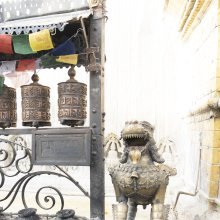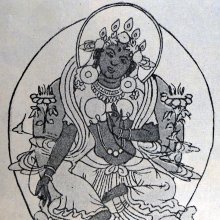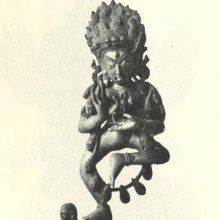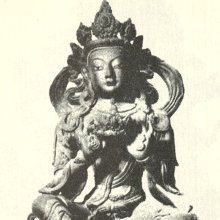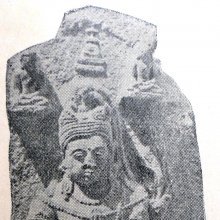Mamaki, Māmakī: 10 definitions
Introduction:
Mamaki means something in Buddhism, Pali, Hinduism, Sanskrit, biology. If you want to know the exact meaning, history, etymology or English translation of this term then check out the descriptions on this page. Add your comment or reference to a book if you want to contribute to this summary article.
Images (photo gallery)
(+4 more images available)
In Buddhism
Tibetan Buddhism (Vajrayana or tantric Buddhism)
Source: Wisdom Library: Tibetan BuddhismMāmakī (मामकी) is the name of Dūtī (i.e., messengers of Lord Vajrapāṇi) mentioned as attending the teachings in the 6th century Mañjuśrīmūlakalpa: one of the largest Kriyā Tantras devoted to Mañjuśrī (the Bodhisattva of wisdom) representing an encyclopedia of knowledge primarily concerned with ritualistic elements in Buddhism. The teachings in this text originate from Mañjuśrī and were taught to and by Buddha Śākyamuni in the presence of a large audience (including Māmakī).
Source: archive.org: The Indian Buddhist IconographyMāmakī (मामकी) is the Śakti, or female counterpart (spiritual consort) of Akṣobhya: one of the Dhyāni-Buddhas, according to Vajrayāna or Tantric Buddhism.—Her colour is blue; and her symbol is the vajra.—According to a Dhyāna in the Advayavajrasaṃgraha, Māmakī belongs to the Vajra family and thus she is the spiritual consort of the Dhyāni Buddha Akṣobhya, the embodiment of the Vajrakula.
Māmakī’s form and nature are described as under:—“On the orb of the Moon in the Nairṛta corner there is Māmakī originating from the blue germ syllable Māṃ. She is blue in colour and has the blue Vajra as her recogntion symbol. She is the embodiment of the element of Water and she belongs to the Vajra family. She is full of enmity”.
Source: Wisdomlib Libary: Vajrayogini1) Māmakī (मामकी) is the presiding deity of the eastern lotus of the vārāhyabhyudaya-maṇḍala, according to the Vārāhyabhyudayatantra (largerly extracted from the 10th century Abhidhānottaratantra). She is the presiding lady (kuleśvarī) of the vajra (Akṣobhya) family. The central deity of the vārāhyabhyudaya-maṇḍala is the twelve-armed Vajravarāhī, which is modeled upon the twelve-armed Cakrasaṃvara, thus inhibiting many similar iconographical features.
Māmakī has three faces of three colors (black, white and red) and is to be visualised as naked and wearing only a agarland of heads, dancing upon the four māras. She has six arms and her attributes include the cihnam (family emblem), the vajra, the double vajra, a red lotus and a wheel.
The lotus upon which Māmakī presides has 6 petals and corresponding goddesses residing in pīṭhas (sacred site):
- Pracaṇḍā in Pullīramalaya,
- Caṇḍākṣī in Jālandhara,
- Prabhāvatī in Oḍḍiyāna,
- Mahānāsā in Arbuda,
- Vīramatī in Godāvarī,
- Kharvarī in Rāmeśvara.
2) Māmakī (मामकी) is the alternative name of Māraṇī: a deity to be contemplated upon by a practicioner purifying his correspondences (viśuddhi), according to the 12th-century Abhisamayamañjarī. Māraṇī is alternatively known by the name Māmakī one of the traditional consorts of the Buddha and a mother of the yogatantra system. The contemplation is prescribed as a preliminary ritual for a yogin wishing to establish, or reestablish the union with a deity.
Māmakī is associated with the element water and the color black. She is to be visualised as assuming a kāpālika form, naked with loose hair and holding tantric attributes in their four arms.
Source: academia.edu: The Structure and Meanings of the Heruka MaṇḍalaMāmakī (मामकी) is the name of a Ḍākinī who, together with the Vīra (hero) named Māmaka forms one of the 36 pairs situated in the Hṛdayacakra, according to the 10th century Ḍākārṇava chapter 15. Accordingly, the hṛdayacakra refers to one of the four divisions of the sahaja-puṭa (‘innate layer’), situated within the padma (lotus) in the middle of the Herukamaṇḍala. The 36 pairs of Ḍākinīs [viz., Māmakī] and Vīras are reddish yellow in color; they each have one face and four arms; they hold a skull bowl, a skull staff, a small drum, and a knife.
Source: OSU Press: Cakrasamvara SamadhiMāmakī (मामकी) is the name of a deity [i.e., oṃ māmakyai svāhā], according to the Guru Mandala Worship (maṇḍalārcana) ritual often performed in combination with the Cakrasaṃvara Samādhi, which refers to the primary pūjā and sādhanā practice of Newah Mahāyāna-Vajrayāna Buddhists in Nepal.—Accordingly, “Locanī, having a golden color, arrow and shining appearance, Māmakī, having a dark-blue color, water, grain and a bouquet, Pāṇḍarā, having a red color, and drawing a bow and arrow, Holy goddess Ārya Tārā, having a green color and blue lotus”.

Tibetan Buddhism includes schools such as Nyingma, Kadampa, Kagyu and Gelug. Their primary canon of literature is divided in two broad categories: The Kangyur, which consists of Buddha’s words, and the Tengyur, which includes commentaries from various sources. Esotericism and tantra techniques (vajrayāna) are collected indepently.
General definition (in Buddhism)
Source: Wisdom Library: Dharma-samgrahaMāmakī (मामकी) refers to the “devoted goddess” and represents one of the “four Goddesses” (caturdevī) as defined in the Dharma-saṃgraha (section 4). The Dharma-samgraha (Dharmasangraha) is an extensive glossary of Buddhist technical terms in Sanskrit (e.g., caturdevī and Māmakī). The work is attributed to Nagarguna who lived around the 2nd century A.D.
Biology (plants and animals)
Source: Google Books: CRC World Dictionary (Regional names)1) Mamaki in Hawaii is the name of a plant defined with Pipturus albidus in various botanical sources. This page contains potential references in Ayurveda, modern medicine, and other folk traditions or local practices It has the synonym Boehmeria albida Hook. & Arnott (among others).
2) Mamaki is also identified with Pipturus arborescens It has the synonym Pipturus asper Wedd. (etc.).
Example references for further research on medicinal uses or toxicity (see latin names for full list):
· Journal of Ethnopharmacology (1995)
· Annales des Sciences Naturelles, Botanique (1854)
· Journal of the Society of Tropical Agriculture (1932)
· Enumeratio Plantarum Horti Regii Berolinensis Altera (1822)
· Species Plantarum (1753)
· Philippine Journal of Science (1911)
If you are looking for specific details regarding Mamaki, for example chemical composition, health benefits, extract dosage, diet and recipes, side effects, pregnancy safety, have a look at these references.

This sections includes definitions from the five kingdoms of living things: Animals, Plants, Fungi, Protists and Monera. It will include both the official binomial nomenclature (scientific names usually in Latin) as well as regional spellings and variants.
Languages of India and abroad
Sanskrit dictionary
Source: Cologne Digital Sanskrit Dictionaries: Edgerton Buddhist Hybrid Sanskrit DictionaryMāmakī (मामकी).—name of a Buddhist goddess: Mahāvyutpatti 4275; Dharmasaṃgraha 4; (Ārya-)Mañjuśrīmūlakalpa 41.5; Sādhanamālā 18.14 etc.
Source: Cologne Digital Sanskrit Dictionaries: Monier-Williams Sanskrit-English DictionaryMāmakī (मामकी):—[from māmaka > māma] f. Name of one of the Buddhist Devīs, [Dharmasaṃgraha 4] ([Monier-Williams’ Buddhism 216]).
Sanskrit, also spelled संस्कृतम् (saṃskṛtam), is an ancient language of India commonly seen as the grandmother of the Indo-European language family (even English!). Closely allied with Prakrit and Pali, Sanskrit is more exhaustive in both grammar and terms and has the most extensive collection of literature in the world, greatly surpassing its sister-languages Greek and Latin.
Nepali dictionary
Source: unoes: Nepali-English DictionaryMāmakī (मामकी):—n. (Buddhism) one of Panchatara (पञ्चतारा [pañcatārā] ); the wife of Ratsambhav and mother of Ratnapani;
Nepali is the primary language of the Nepalese people counting almost 20 million native speakers. The country of Nepal is situated in the Himalaya mountain range to the north of India.
See also (Relevant definitions)
Starts with: Mamakina.
Full-text (+61): Mamaka, Mamukhi, Devoted goddess, Vedyaramitah, Thapim, Thvam, Manjaridharin, Nilavarna, Dhanyadhari, Mantrotpatti, Ghatadhari, Khay, Tattvayogajnana, Caturdevi, Samgini, Sanga, Akshayabhava, Sangin, Vakya, Sangasangi.
Relevant text
Search found 7 books and stories containing Mamaki, Māmakī; (plurals include: Mamakis, Māmakīs). You can also click to the full overview containing English textual excerpts. Below are direct links for the most relevant articles:
The Indian Buddhist Iconography (by Benoytosh Bhattachacharyya)
Garga Samhita (English) (by Danavir Goswami)
Verse 6.21.31 < [Chapter 21 - In the Description of the Third Fort, the Glories of Piṇḍāraka-tīrtha]
Guhyagarbha Tantra (with Commentary) (by Gyurme Dorje)
Text 8.9-10 (Commentary) < [Chapter 8 (text and commentary)]
Text 4.18 (Commentary) < [Chapter 4 (text and commentary)]
Text 2.2 (Commentary) < [Chapter 2 (text and commentary)]
The Great Chariot (by Longchenpa)
Part 4a.3 - Meditating on the deities < [B. The explanation of meditation practice, together with its action of ripening and freeing]
Part 4a.4 - The great mandala of the environment and inhabitants < [B. The explanation of meditation practice]
Part 4c - The accompanying samaya and action/practice < [B. The explanation of meditation practice, together with its action of ripening and freeing]
Hindu Pluralism (by Elaine M. Fisher)
Śaṅkarācāryas and Smārta Brahmins < [Chapter 2 - The Making of the Smārta-Śaiva Community of South India]
The gods of northern Buddhism (by Alice Getty)
